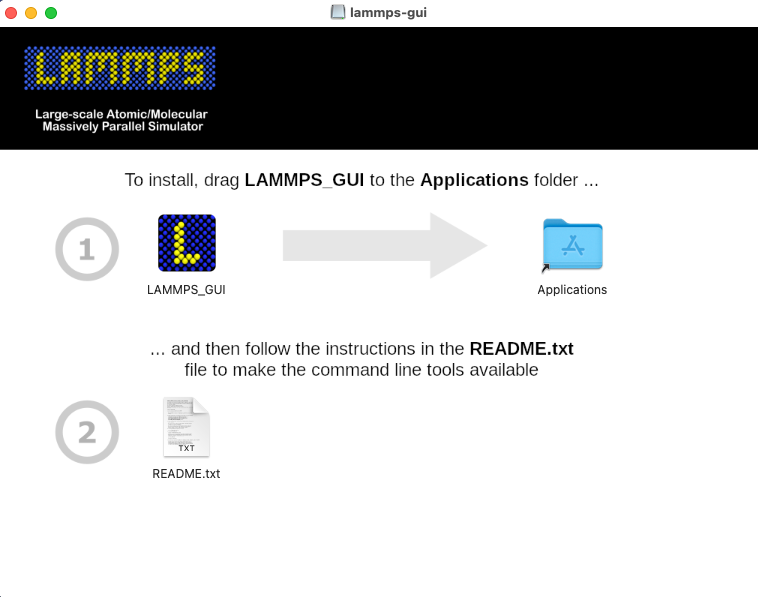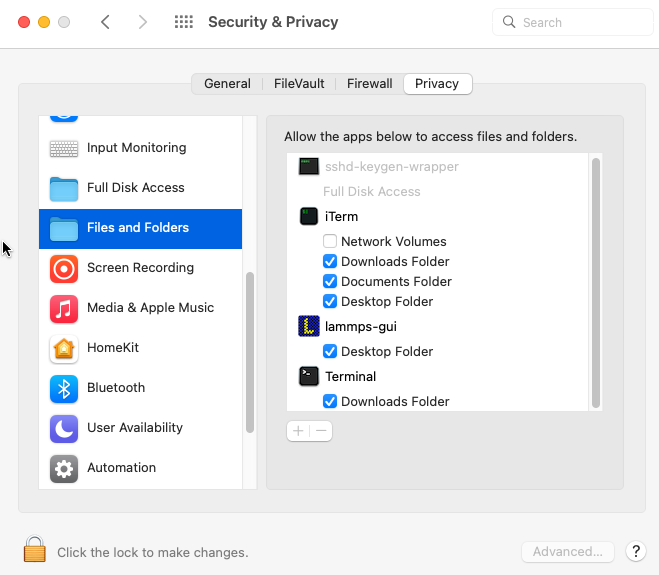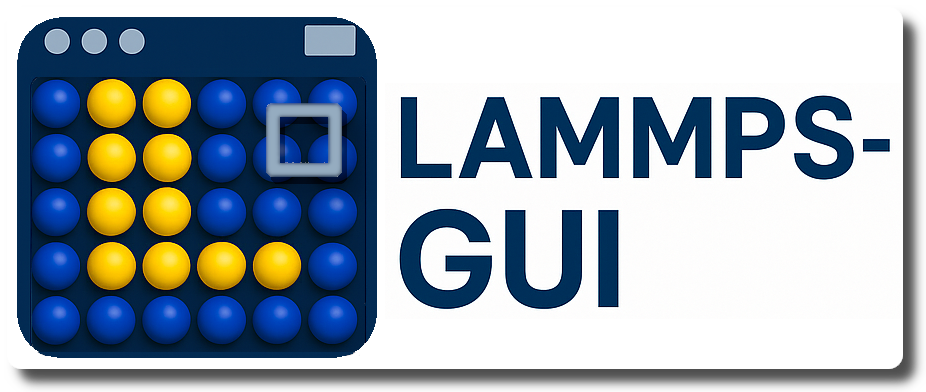1. Installation¶
LAMMPS-GUI is distributed as source code on GitHub and can be compiled as part of compiling LAMMPS, where it will be linked to the corresponding version of LAMMPS directly. Pre-compiled packages of LAMMPS with LAMMPS-GUI included are available for download (see below).
LAMMPS-GUI can also be compiled as a standalone package and load the LAMMPS library dynamically at runtime. This enables using LAMMPS-GUI with customized, patched, or extended LAMMPS versions containing features not available in the official LAMMPS distribution packages. It also allows to use LAMMPS-GUI with LAMMPS shared libraries compiled using the traditional makefile based build process (which does not support compiling LAMMPS-GUI directly). Pre-compiled packages of standalone LAMMPS-GUI versions with some basic LAMMPS shared library included are also available for download (see below).
1.1. Prerequisites and portability¶
LAMMPS-GUI is programmed in C++ based on the C++17 standard and using the Qt GUI framework. Currently, Qt version 5.15LTS or later is required; support for Qt version 6.x is available, too. When compiled With Qt version 6.x, LAMMPS-GUI can switch between a “light” and a “dark” theme according to the settings of the desktop environment. Otherwise, there are no changes in functionality between using either major version of Qt. Building LAMMPS-GUI requires CMake version 3.20 or later.
LAMMPS-GUI 1.9.0 has been successfully compiled and tested on:
Ubuntu Linux 22.04LTS x86_64 using GCC 11, Qt version 5.15
Fedora Linux 41 x86_64 using GCC 14 and Clang 17, Qt version 5.15
Fedora Linux 43 x86_64 using GCC 15, Qt version 6.10
Apple macOS 12 (Monterey) and macOS 13 (Ventura) with Xcode on arm64 and x86_64, Qt version 5.15
Windows 10 and 11 x86_64 with Visual Studio 2022 and Visual C++ 14.36, Qt version 5.15
Windows 10 and 11 x86_64 with Visual Studio 2022 and Visual C++ 14.40, Qt version 6.7
Windows 10 and 11 x86_64 with MinGW / GCC 15.2 cross-compiler on Fedora 43, Qt version 6.10
1.2. Pre-compiled executables¶
1.2.1. Packages including a full LAMMPS version¶
For many users and especially for beginners learning to use LAMMPS, it is most convenient to install and use one of the pre-compiled packages that include both, LAMMPS-GUI and the command-line version of LAMMPS. In these packages LAMMPS-GUI is linked directly to the included LAMMPS library and thus it cannot be changed in the LAMMPS-GUI perferences dialog. Such pre-compiled LAMMPS executable packages are available for download for Linux x86_64 (Ubuntu 22.04LTS or later and compatible), macOS (version 11 aka Big Sur or later), and Windows (version 10 or later) from the LAMMPS releases page on GitHub. A backup download location is at https://download.lammps.org/static/ but may not always be up-to-date. Occasionally, also test version packages previewing recently added features are available at https://download.lammps.org/testing/ .
1.2.2. Standalone packages with a basic LAMMPS library¶
LAMMPS-GUI packages containing only LAMMPS-GUI compiled in plugin mode are available from the LAMMPS-GUI releases page on GitHub. These packages include a LAMMPS shared library with some subset of LAMMPS’ features that do not depend on additional libraries.
If you want to override that choice of LAMMPS library, you can use the
-p command line flag to tell LAMMPS-GUI which other LAMMPS shared
library file you want it to load. By using -p "" you can also reset
any previous choice and thus trigger loading the default library again.
Once LAMMPS-GUI is running, you can also change the path to the LAMMPS
shared library from the Preferences dialog.
As of LAMMPS-GUI version 1.9.0 and since LAMMPS-GUI version 1.8.4, the minimum LAMMPS version required is 22 July 2025 update 2.
1.2.3. GPU support and MPI parallelization¶
The pre-compiled packages include support for GPUs through the GPU package with OpenCL (in mixed precision). However, this requires that you have a compatible driver and the OpenCL runtime installed. This is not always available and when using the flatpak bundle, the flatpak sandbox usually prevents accessing the GPU. GPU support through the KOKKOS package is currently not available for technical reasons, but serial and OpenMP multi-threading use of KOKKOS is available.
The design decisions for LAMMPS-GUI and how it launches LAMMPS conflict with parallel runs using MPI. You have to use a regular LAMMPS executable compiled with MPI support for that. For the use cases that LAMMPS-GUI has been conceived for (learning LAMMPS, testing or debugging LAMMPS inputs, prototyping new projects or complex workflows), this is not a significant limitation. Many supercomputing centers and high-performance computing clusters have parallel LAMMPS pre-installed.
1.2.4. Platform notes¶
Windows 10 and later¶
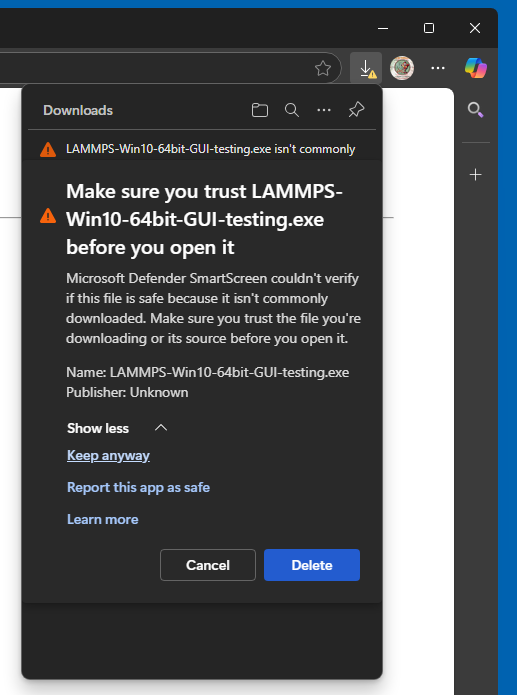
After downloading either the LAMMPS-Win10-64bit-GUI-<LAMMPS version>.exe
or the LAMMPS-GUI-Win10-x86_64-<LAMMPS-GUI version>.exe installer
package, you need to execute it, and start the installation process.
Depending on your security settings of your web browser, you may have to
explicitly tell it to download the file and then confirm twice to
keep the downloaded file despite the claims that it may be dangerous
and insecure. Since the installer packages are currently not
cryptographically signed, you may also have to enable “Developer Mode”
in the Windows System Settings to be able to run the installer.

MacOS 11 and later¶
After downloading the LAMMPS-macOS-multiarch-GUI-<LAMMPS version>.dmg
or LAMMPS-GUI-multiarch-<LAMMPS-GUI version>.dmg application bundle disk
image, you need to double-click it and then - in the window that opens -
drag the app bundle as indicated into the “Applications” folder. Afterwards,
the disk image can be unmounted or ejected. Then follow the instructions in
the “README.txt” file to get access to the other included command-line
executables, if desired.
Linux on x86_64¶
For Linux with x86_64 CPU there are currently two variants of pre-compiled LAMMPS-GUI: 1) a tar file with binaries and a wrapper script and 2) a flatpak bundle. The first is currently compiled on Ubuntu 22.04LTS (the oldest popular Linux distribution that provides the required C++17 compatibility out of the box) and depends on the backward compatibility of the core libraries between different releases on Linux distributions, and should be compatible with most recent Linux distributions. The second uses the flatpak sandbox environment to maintain binary compatibility across platforms.
Linux binary tarball
After downloading and unpacking the
LAMMPS-Linux-x86_64-GUI-<LAMMPS version>.tar.gz or the
LAMMPS-GUI-Linux-x86_64-<LAMMPS-GUI version>.tar.gz package,
you can switch into the “LAMMPS_GUI” folder and execute
“./lammps-gui” directly:
$ cd ~/Downloads
$ tar -xzvvf LAMMPS-Linux-x86_64-GUI-22Jul2025.tar.gz
$ cd LAMMPS_GUI
$ ./lammps-gui &
The LAMMPS_GUI folder may also be moved around and added to the
PATH environment variable so the executables will be found
automatically.
Installing required compatibility packages
Since software is constantly evolving, it may be required to install
additional software packages for your Linux distribution to achieve
compatibility with binaries compiled on older distributions. For
example the libraries libxcb-xinput.so.0 and
libxcb-xinerama.so.0 may be missing and you thus get the error
qt.qpa.plugin: Could not load the Qt platform plugin "xcb" in "" even though it was found.
On Ubuntu 24.04 for example, those libraries are in the packages
libxcb-xinput0 and libxcb-xinerama0 which are not installed
by default. Using the flatpak bundle (see below) avoids these kind
of issues by compiling and running the application in a standardized
sandbox which is maintained by the flatpak software manager.
Linux flatpack bundle
The second Linux package variant uses flatpak and requires the flatpak management and
runtime software to be installed. After downloading the
LAMMPS-GUI-Linux-x86_64-GUI-<version>.flatpak flatpak bundle, you
can install it with:
$ cd ~/Downloads
$ flatpak install --user LAMMPS-GUI-Linux-x86_64-GUI-<version>.flatpak
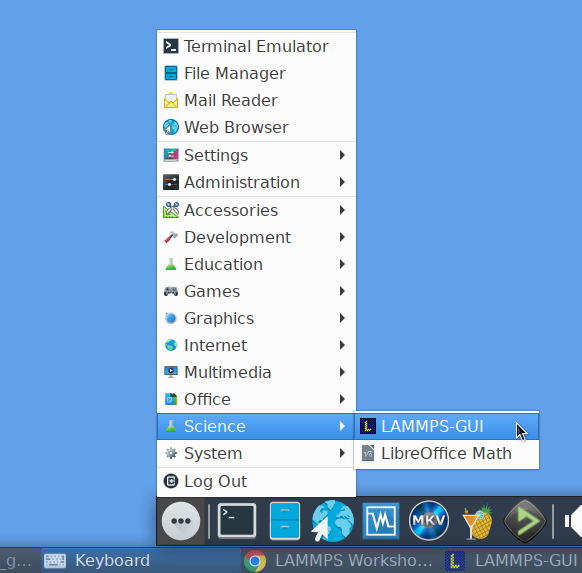
After installation, LAMMPS-GUI should be integrated into your desktop
environment under “Applications > Science” but also can be launched from
the console with flatpak run org.lammps.lammps-gui. The flatpak
bundle also includes the console LAMMPS executable lmp which can be
launched to run simulations with, for example with:
flatpak run --command=lmp org.lammps.lammps-gui -in in.melt
Other bundled command-line executables are run the same way and can be listed with:
ls $(flatpak info --show-location org.lammps.lammps-gui )/files/bin
1.3. Compilation from source¶
The source for LAMMPS-GUI was included with the LAMMPS source code
distribution until LAMMPS version 22 July 2025 in the folder
tools/lammps-gui. Starting with LAMMPS-GUI version 1.8.0 and
LAMMPS version 10 September 2025 the LAMMPS-GUI sources are distributed
separately through its own git repository at
https://github.com/akohlmey/lammps-gui.
LAMMPS-GUI can still be built as part of a regular LAMMPS
compilation. It will be automatically downloaded from its git
repository and configured. This is usually the most convenient way.
Since CMake is required
to build LAMMPS-GUI, you need to build LAMMPS with CMake as well. To
enable its compilation during compiling LAMMPS, the CMake variable -D
BUILD_LAMMPS_GUI=on must be set when creating the CMake configuration.
All other settings (compiler, flags, compile type) for LAMMPS-GUI are
then inherited from the regular LAMMPS build. If the Qt library is
installed as packaged for Linux distributions, then its location is
typically auto-detected since the required CMake configuration files are
stored in a location where CMake can find them without additional help.
Otherwise, the location of the Qt library installation must be indicated
by setting -D Qt5_DIR=/path/to/qt5/lib/cmake/Qt5, which is a path to
a folder inside the Qt installation that contains the file
Qt5Config.cmake. Similarly, for Qt6 the location of the Qt library
installation can be indicated by setting -D
Qt6_DIR=/path/to/qt6/lib/cmake/Qt6, if necessary. When both, Qt5 and
Qt6 are available, Qt6 will be preferred unless -D
LAMMPS_GUI_USE_QT5=yes is set.
1.3.1. LAMMPS-GUI plugin version¶
It is possible to compile a standalone LAMMPS-GUI executable (e.g. when
LAMMPS has been compiled with traditional make). Rather than linking to
the LAMMPS library during compilation, it includes a plugin loader that will
load a LAMMPS shared library file dynamically at runtime during the
start of the GUI; e.g. liblammps.so.0 or liblammps.0.dylib or
liblammps.dll (depending on the operating system). This has the
advantage that the LAMMPS library can be built from updated or modified
LAMMPS source without having to (re-)compile the GUI.
The ABI of the LAMMPS C-library interface is very stable and generally
backward compatible. However, features used in LAMMPS-GUI may require a
minimum LAMMPS version of the library. LAMMPS-GUI will print a suitable
error message and exit if an incompatible LAMMPS library is loaded. You
can override the path to the LAMMPS library with the -p <path> or
--pluginpath <path> command-line flag. This is usually
auto-detected on the first run and can be changed in the LAMMPS-GUI
Preferences dialog. The command-line flag allows to reset this path
to a valid value in case the original setting has become invalid. An
empty path (“”) as argument restores the default setting.
It is also possible to link the standalone compiled LAMMPS-GUI version
to the LAMMPS library directly. This feature is enabled by setting -D
LAMMPS_GUI_USE_PLUGIN=off (default setting is on). This is also the
setting for compilation within LAMMPS. In this case, the CMake
configuration needs to be told where to find the LAMMPS headers and the
LAMMPS library, via -D LAMMPS_SOURCE_DIR=/path/to/lammps/src.
1.3.2. Platform notes¶
macOS¶
When building on macOS, the build procedure will try to manufacture a
drag-n-drop installer, LAMMPS-GUI-macOS-multiarch-<version>.dmg,
when using the ‘dmg’ target (i.e. cmake --build <build dir> --target
dmg or make dmg.
To build multi-arch executables that will run on both, arm64 and x86_64
architectures natively, it is necessary to set the CMake variable -D
CMAKE_OSX_ARCHITECTURES=arm64;x86_64. To achieve wide compatibility
with different macOS versions, you can also set -D
CMAKE_OSX_DEPLOYMENT_TARGET=11.0 which will set compatibility to macOS
11 (Big Sur) and later, even if you are compiling on a more recent macOS
version.
Windows¶
On Windows either native compilation from within Visual Studio 2022 with Visual C++ is supported and tested, or compilation with the MinGW / GCC cross-compiler environment on Fedora Linux.
Visual Studio
Using CMake and Ninja as build system are required. Qt needs to be
installed, tested was a binary Qt package downloaded from
https://www.qt.io, which installs into the C:\\Qt folder by default.
There is a custom x64-GUI-MSVC build configuration provided in the
CMakeSettings.json file that Visual Studio uses to store different
compilation settings for project. Choosing this configuration will
activate building the lammps-gui.exe executable in addition to LAMMPS
through importing package selection from the windows.cmake preset
file and enabling building LAMMPS-GUI and disabling building with
MPI. When requesting an installation from the Build menu in Visual
Studio, it will create a compressed LAMMPS-GUI-Win10-amd64.zip zip file
with the executables and required dependent .dll files. This zip file
can be uncompressed and lammps-gui.exe run directly from there. The
uncompressed folder can be added to the PATH environment and LAMMPS
and LAMMPS-GUI can be launched from anywhere from the command-line.
MinGW64 Cross-compiler
The standard CMake build procedure for cross-compilation can be applied.
By using the mingw64-cmake wrapper the CMake configuration will
automatically include a suitable CMake toolchain file (the regular cmake
command can be used after that to modify the configuration settings, if
needed). After building the libraries and executables, you can build
the target ‘nsis’ (i.e. cmake --build <build dir> --target nsis or
make nsis to build an Nullsoft installer package executable that
can be executed on a Windows 10 or later machine with x86_64 CPU and
will then install LAMMPS-GUI including a basic LAMMPS shared library
file and all required dependencies.
Linux¶
Binary tarball package
Version 5.15 or later of the Qt library is required. Those are provided
by, e.g., Ubuntu 22.04LTS or later. Thus older Linux distributions are
not likely to be supported, while more recent ones will work, even for
pre-compiled executables (see above). After compiling with
cmake --build <build folder>, use cmake --build <build
folder> --target tgz or make tgz to build a
LAMMPS-Linux-amd64.tar.gz file with the executables and their
support libraries.
Flatpak bundle
It is also possible to build a flatpak bundle which is
a way to distribute applications in a way that is compatible with most
Linux distributions (provided the flatpak system is installed). Use the
“flatpak” target to trigger a compile (cmake --build <build
folder> --target flatpak or make flatpak). Please note that this
will not build from the local sources but from the repository and branch
listed in the org.lammps.lammps-gui.yml LAMMPS-GUI source folder.
Flatpak builds are currently only supported when building LAMMPS-GUI
from within LAMMPS due to restrictions imposed by the flatpak sandbox.
